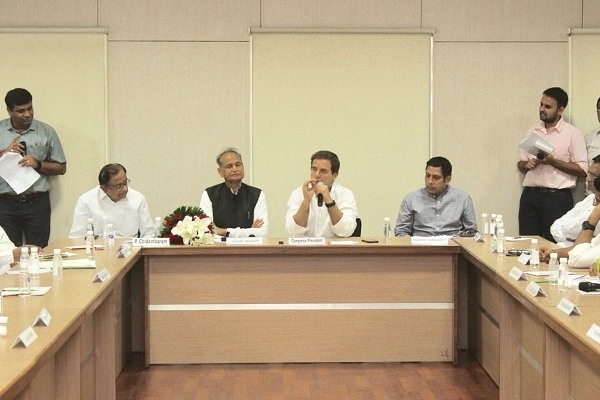Politics
Rahul’s Data Chief Uses Inappropriate Tax Numbers To Prove Rising Inequality
- Praveen Chakravarty used questionable data to suggest that inequality was rising.
- He used taxpayer statistics dished out by the CBDT to show this “fact”.
- The idea of using only taxpayer data to make the point of rising inequality falls flat.

Praveen Chakravarty is seated to the left of Rahul Gandhi. (Praveen Chakravarty/Twitter)
The Congress party’s Data Analytics chairperson, Praveen Chakravarty, made an important, but probably inadvertent, confession a few days ago: income inequality had grown under the United Progressive Alliance (UPA) regime.
Writing in the Hindustan Times to rebut an article written by Surjit Bhalla, part-time member of the Economic Advisory Council to the Prime Minister, who believes that rising income inequality in India is devoid of data support, Chakravarty said that the opposite was the case.
To disprove Bhalla, Chakravarty used even more questionable data to suggest that inequality was, in fact, rising. He used taxpayer statistics dished out by the Central Board of Direct Taxes (you can download the data sets here) to show this “fact”, when taxpayers are barely 5 per cent of the adult population. Unfortunately, he got both his methodology and some observations wrong. And even if inequality is rising, it relates largely to the UPA’s end years. Conclusive data on inequality in the National Democratic Alliance (NDA) years is yet to surface.
The two data years he mined using taxpayer data are 2011-12 (i.e., assessment year 2012-13) and 2014-15 (assessment year 2015-16), the first being roughly the year from which the Indian economy went into a tailspin; the second is the last year of the UPA (first two months), and the first 10 months of the NDA. If we assume that no economic turnaround happens even before a new government has had a full year to make its policies effective, the results for 2014-15 largely relate to what the UPA did.
Chakravarty argues that the Gini coefficient, a widely accepted measure of income equality, rose from 0.48 to 0.63 in these two years. A Gini of zero means perfect equality, with everyone receiving the same income, and a figure of one means perfect inequality, with one per cent owning all the incomes generated. The higher the coefficient, the greater the inequality.
The World Bank, using more sensible data from a broader range of household incomes and official data, put the Gini coefficient at 0.35 in 2011. Thomas Piketty and Lucas Chancel, in their much-touted 2017 study of inequality in India, From British Raj to Billionaire Raj, put the Gini at 0.5 per cent.
So, whichever way you look at it, Chakravarty’s calculation of a Gini of 0.63 in 2014-15 is way off the mark. Clearly, the idea of using only taxpayer data to make the point of rising inequality falls flat. And, in any event, the Gini has been rising largely in the final years of the UPA, a point his boss, Rahul Gandhi, may not be happy to accept.
Some of the claims made by Chakravarty to show how some people have very high incomes, again using income-tax returns statistics, are questionable.
In his Hindustan Times article, he highlights the point about growing inequality and writes: “For instance, while there were 273 people that earned more than Rs 500 crore in 2016, more than half of all income tax filers earned less than a mere Rs 3.5 lakh. And, these 273 people accounted for one-fifth of all combined income of the nearly 50 million taxpayers in 2016.”
The problem with this claim is simple: the 273 “people” who allegedly earned more than Rs 500 crore of gross total income were not “people”, but largely companies. Nor were they Hindu Undivided Families or even small firms or associations of persons (AoPs). In this total of 273 with gross total incomes above Rs 500 crore, there was only one solitary individual and one AoP. The rest were all companies.
Now, if you take company income into Gini calculations, you are going to get an absurd result.
This is absolutely not about arguing that there has been no rise in inequality – that could well be the case, especially since UPA-era growth was high relative to the NDA’s four years. It is a well-established fact that high growth usually increases inequality. But surely the Congress party’s data cruncher could have proved this with better data sets? Even the much-more-painstakingly gathered inequality data of Piketty & Chancel has been questioned, but Chakravarty’s effort qualifies as selective use of data for polemics, not research.
Introducing ElectionsHQ + 50 Ground Reports Project
The 2024 elections might seem easy to guess, but there are some important questions that shouldn't be missed.
Do freebies still sway voters? Do people prioritise infrastructure when voting? How will Punjab vote?
The answers to these questions provide great insights into where we, as a country, are headed in the years to come.
Swarajya is starting a project with an aim to do 50 solid ground stories and a smart commentary service on WhatsApp, a one-of-a-kind. We'd love your support during this election season.
Click below to contribute.
Latest